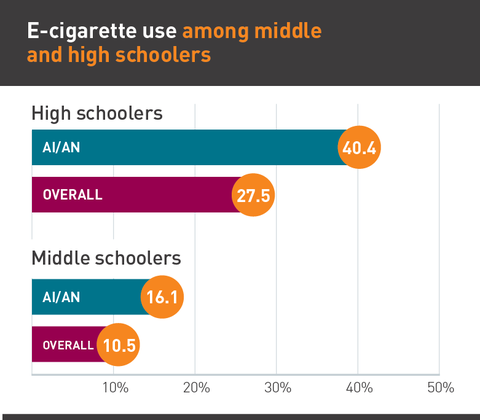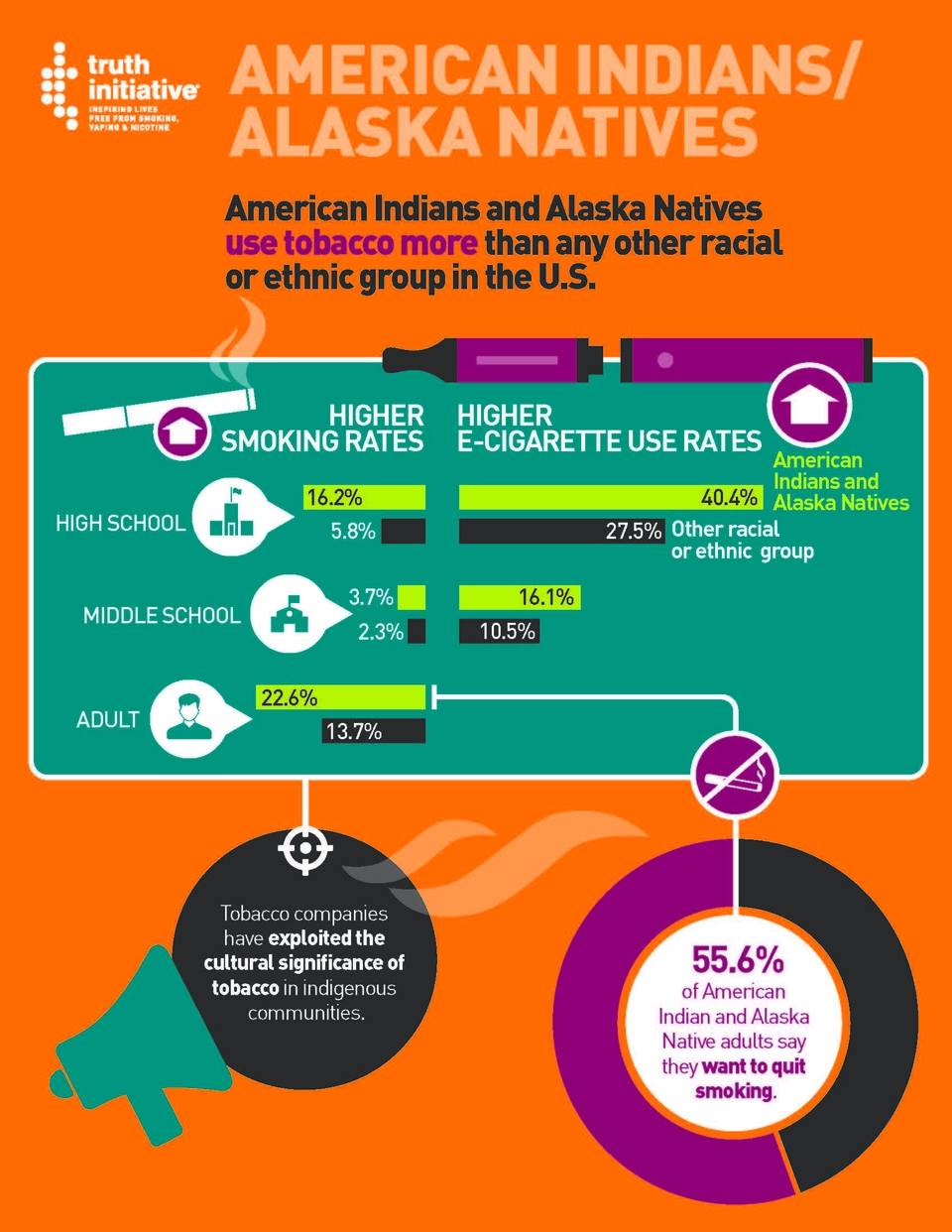Tobacco use in the American Indian/Alaska Native community
American Indians and Alaska Natives use tobacco more than any other racial or ethnic group in the United States. Commercial tobacco use is distinct from the cultural traditions involving tobacco that are central to many indigenous communities. These communities consider traditional tobacco a symbol for peace and healing and a sacred gift of the earth and use it in medicinal and spiritual ceremonies and for instructional purposes. The use of “tobacco” throughout this report refers to commercial tobacco use.
PATTERNS OF USE IN THE U.S.
YOUTH
- American Indian and Alaska Native high schoolers have the highest current cigarette smoking rate of any other race or ethnicity at 16.2%, compared to 5.8% overall.
- Among American Indian and Alaska Native middle schoolers, 3.7% currently smoke cigarettes compared to 2.3% of middle schoolers overall.
- According to 2019 National Youth Tobacco Survey data, 16.1% of American Indian and Alaska Native middle schoolers and 40.4% of American Indian and Alaska Native high schoolers were current e-cigarette users. This is much higher than the general population rate of 27.5% among high schoolers and 10.5% among middle schoolers.
ADULTS
- American Indian and Alaska Native adults have the highest smoking rate in the U.S. More than 1 in 5 (22.6%) adult American Indians and Alaska Natives currently smoke cigarettes compared to 13.7% of adults overall.
- An estimated 55.6% of American Indian and Alaska Native adults report that they want to quit smoking. This is lower than other ethnic groups. By comparison, 72.8% of African Americans, 69.6% of Asians, 67.5% of whites and 67.4% of Hispanics report wanting to quit.
- In 2017, 2.5% of American Indian and Alaska Native adults were current e-cigarette users. This is lower than the general population rate for adults, which is 2.8%.
More than 1 in 5 American Indian and Alaska Native adults currently smoke cigarettes.
INDUSTRY TARGETING
The tobacco industry has a well-documented history of targeting minority and marginalized populations, including American Indians and Alaska Natives. Targeted marketing and advertisements can be directly linked to tobacco use.
- Red Man chewing tobacco began targeting American Indians and Alaska Natives in 1901 by drawing on the “mystique of Indian-ness” with American Indian chief and Native American headdress images, for example. This imagery and symbolism was carried well into the 1950s and even today, as seen in ads for Velvet, Old Gold, Kent and Natural American Spirit cigarettes.
- Although tobacco has cultural significance, romanticized images of American Indians and Alaska Natives have been used for decades to market and sell commercial tobacco products in order to portray them as natural and a spiritual experience. These tactics not only misappropriated indigenous culture, but also reinforced harmful stereotypes of American Indians. Prominent tobacco company Natural American Spirit is a primary offender.
A recent congressional investigation found that the e-cigarette manufacturer JUUL targeted at least eight American Indian tribes with price discounts and referral program pitches in an effort to promote its products.
HEALTH EFFECTS
Tobacco use is associated with heart disease and cancer, the two leading causes of death among American Indian and Alaskan Native adults.
- Heart disease is the primary cause of death in the U.S. and among American Indians and Alaska Natives. In 2016, heart disease killed more than 3,300 American Indians and Alaska Natives.
- Cancer is the second leading cause of death in the U.S. and among American Indians and Alaska Natives. Nearly 18% of American Indian deaths are attributable to cancer. More than 3,200 American Indians and Alaska Natives died of cancer in 2016.
- More than 800 American Indians and Alaska Natives died of lung cancer in 2016 — 445 men and 372 women. American Indian and Alaska Native men have lower death rates for lung cancer than African American and white men, but higher death rates than Asian American and Hispanic men.
- Smoking increases the risk for strokes,16 the fifth leading cause of death in the U.S. In 2016, more than 600 American Indians and Alaska Natives died of stroke.
Because people who identify themselves as American Indian or Alaska Native are sometimes reported as white on death certificates, the figures provided above may underestimate the real number of deaths among American Indians and Alaska Natives.





